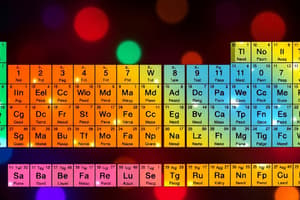Podcast
Questions and Answers
What is a consequence of a greater effective nuclear charge in noble gas atoms?
What is a consequence of a greater effective nuclear charge in noble gas atoms?
- They are somewhat smaller than the neighboring halogen atoms (correct)
- They have weaker electronegativities than the halogens
- They have lower ionization energies than the halogens
- They are larger than the neighboring halogen atoms
Why are the high electronegativities predicted for the noble gases reasonable?
Why are the high electronegativities predicted for the noble gases reasonable?
- Because the noble gas atoms have lower ionization energies than the halogens
- Because the noble gas atoms are larger than the neighboring halogen atoms
- Because the noble gas atoms have weaker electronegativities than the halogens
- Because the noble gas atoms have a strong attraction on electrons of neighboring atoms (correct)
What is true about the ionization energies of the noble gases compared to the halogens?
What is true about the ionization energies of the noble gases compared to the halogens?
- They are dependent on the neighboring atoms
- They are similar
- They are higher (correct)
- They are lower
What is a characteristic of the noble gas atoms that leads to their high electronegativities?
What is a characteristic of the noble gas atoms that leads to their high electronegativities?
What is true about the electronegativities of the noble gases compared to the halogens?
What is true about the electronegativities of the noble gases compared to the halogens?
What is the primary way that the main group elements complete their electron configurations?
What is the primary way that the main group elements complete their electron configurations?
Which group of elements is characterized by high ability to conduct heat and electricity, and malleability?
Which group of elements is characterized by high ability to conduct heat and electricity, and malleability?
What is plotted in Figure 8.1?
What is plotted in Figure 8.1?
What is a characteristic difference between metals and nonmetals?
What is a characteristic difference between metals and nonmetals?
What type of elements have localized electrons and covalently bonded pairs that are less mobile?
What type of elements have localized electrons and covalently bonded pairs that are less mobile?
What is a common characteristic of elements along the diagonal from boron to polonium?
What is a common characteristic of elements along the diagonal from boron to polonium?
Flashcards are hidden until you start studying




